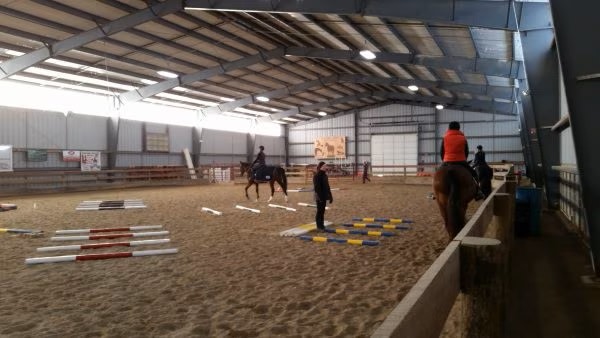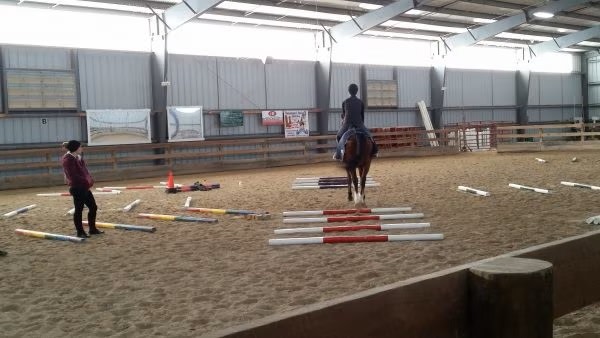Ground Pole Exercises for Horses to Strengthen and Have Fun!
- Benefits of Pole Work for Horse and Rider
- Setting the Right Ground Pole Distances
- How Often to Do Pole Work with Your Horse
- Riding Types of Ground Pole Exercises
Updated May 4, 2023

A fundamental part of training for many different disciplines, ground pole exercises can be of benefit to both horse and rider for so many reasons. Typically, trot poles are simple to set up, offer many different options, and engage your horse physically and mentally. Plus, they are a fun way to switch up your training routine! We will cover some types of pole work, how to set them up, and some of the benefits these exercises can provide for you and your horse.
Benefits of Pole Work for Horse and Rider
There are lots of reasons why horses and riders of all disciplines should try adding ground poles into their training routine. Whether you are a beginner or expert, have a young or older horse, compete or just ride for fun, you can absolutely benefit from some fun ground pole exercises. Here are some advantages of incorporating trotting poles, raised pole exercises, patterns, bending poles, and gymnastics into your horse’s training.
Benefits for Different Riding Disciplines

Pole work provides many muscular benefits for your horse. Considering that all the disciplines require fitness and engagement, doing this type of work on a regular basis will contribute to success in western performance, jumping, dressage, endurance riding, and anywhere in between. Key benefits may include:
- Building topline
- Engaging the hindquarters
- Increasing suppleness
- Helping maintain balance
Helpful at Any Age
Young or “seasoned,” horses and riders of any age can participate and benefit from ground pole patterns. When horses are young, it’s crucial to work their brain just as much as their body. Teaching patience, concentration, focus, and listening to the rider are key. Incorporating poles into your training schedule is a way to hone these qualities without overwhelming your horse.
Based on where your horse is in its training program, starting with some of the simpler exercises and then working up to the more difficult ones will gradually work their mind and body and be a good tool to gauge their maturity level. This will also build their topline muscles and encourage them to engage their hindquarters in a new way.
For older or schoolmaster horses, these activities are often a way to “spice up” their regular routine. Setting up different pole exercises will engage them mentally while working some of their muscles that might not get used as often. Further, middle-aged and senior horses may not be as supple as the younger ones, and using these to help with suppleness, flexibility, and balance on a regular basis may be helpful.
Adjustable for All Skill Levels
As far as rider ability, you can change the pole pattern’s difficulty and distances to be suitable for beginners through advanced riders. For beginners, walking over some simple poles will help to teach steering, straightness, and balance. Ground poles can also help to build trust between horse and rider. For advanced riders, trickier gridwork, gymnastics, and canter poles can assist with fitness and mental challenges. You can also raise your ground pole skills to the next level by incorporating cavelettis!
Setting the Right Ground Pole Distances

When setting up your ground poles, start by placing 2-4 poles approximately 2.5 ft apart for walking, 4 ft apart for trotting, and 9-11 ft apart for cantering. Put your poles down on a long side of the arena to start so horse and rider can approach straight with enough time and space to prepare.
Gaited horses will need about 8 ft between to allow for lateral gaits. These guidelines are based on an average (15.2 hand) horse, so if your horse is larger or smaller you may need to add or subtract in distance.
How Often to Do Pole Work with Your Horse
How often you incorporate ground poles into your horse’s training will vary based on your horse’s condition, age, and level of fitness. It is generally recommended to introduce one easy pole exercise at a time for about five minutes then build up to 15 minutes in the next two to three training sessions.
Simply walking over poles is typically okay to do every day, but trotting or cantering ground poles is only advised about twice a week to allow your horse time to recover from the intensity of the workout.
Riding Types of Ground Pole Exercises

Begin by warming up your horse at the walk, trot, and canter in both directions, making sure you both feel relaxed and focused. You can also do some ground poles in hand first if you prefer, at the walk or trot.
Simple Pole Exercises
Introduce a few poles at the walk, emphasizing obedience, straightness, and forward energy. Add some trot poles next, starting with three poles set at two strides with the same focus as well as rhythm and impulsion, applying the “gas” or “brakes” as needed. Once you’re comfortable with this starter exercise, you can slowly introduce different types of pole arrangements, including straight poles, curved poles, skinny poles, elevated poles, and offset poles.
Putting Together Pole Patterns
After you’ve mastered a few of the more advanced arrangements, you can start to put together combinations that will challenge you to plan ahead and your horse to settle, listen, and focus. For example, you can set up four poles on the diagonal followed by a three-stride space (the “get-it-together” space) then four more poles.
Another example could be a 45 degree turn from a set of poles on the centerline to a set of poles on a diagonal. Even more difficult is a 90 degree turn from poles on one diagonal to poles on the other diagonal.
Ground Pole Courses
Once you are confidently and consistently going through each combination, you can put them all together, adding many poles and creating a more comprehensive exercise. Because there is a lot to think about while “on course,” have a clear image in your mind from pole set to pole set, thinking about your turns with clear descriptions like “centerline rainbow then left to purple.”
Trot Poles with a Twist

Looking to add more variety than the classic trot poles?This exercise is fairly simple to set up, and only requires jump blocks and poles. Place the poles in the center of the ring at 90-degree angles, meeting in the middle. Then raise up the outside ends on the jump blocks. Tack up your horse and you’re ready to ride!
The first time you try this exercise, it is suggested that you walk your horse through the poles. This way your horse can figure out where the poles are and where they need to put their feet. Praise your horse when they do it correctly, so they begin to understand what you’re looking for and how to navigate the exercise.
Once your horse is walking over the poles in a relaxed manner, try it at the trot. If this exercise is new to your horse, he may need a few times to understand what you’re asking as he may want to jump it at first! Trotting him up to it and walking a few strides out to help him understand may be a good start and sitting the trot may help, too.

Once you and your horse are confident over the exercise at the trot, you can try it at the canter! Your horse may enjoy doing this from the canter since he can simply step over the poles right out of stride, rather than potentially trying to jump them from the trot. If you’re feeling ambitious, you can continue down the long side and pop over either of the poles with one end propped up.
When you’re ready to advance past this, you can swap where the jump blocks are. Take the blocks from under the outside edges of the poles and put one block in the middle. The block will hold up all four ends of the poles in the center.

Whether you start with the basics or try out some of the more challenging pole exercises we’ve outlined, most importantly, we hope that you and your horse have fun and learn together!